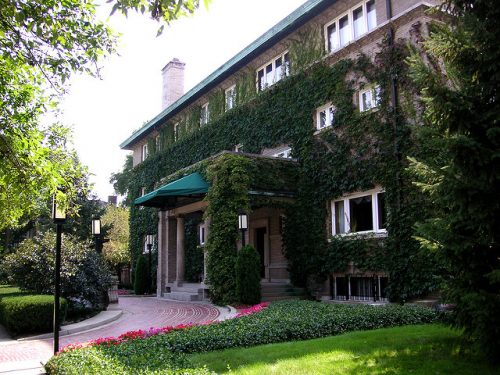The Julius Rosenwald Family
By Megan McKinney
Designed by Nimmons & Fellows, the Rosenwald house in Kenwood was built in 1902. The architects would later become designers of Sears’ houses.
In 1890, Sears tycoon Julius Rosenwald married 20-year-old Augusta “Gussie” Nusbaum, and, after a brief honeymoon trip to Niagara Falls, they settled into a long and satisfying marriage.

Julius and Gussie Rosenwald in 1890, the year of their marriage.
The couple raised five children, Lessing, Adele, Edith, Marion and William, in a spacious house at 4901 S. Ellis Ave. in Chicago’s Kenwood neighborhood, surrounded by one of the largest yards in the city. Although the house and grounds were tended by a sizeable staff of servants, the children walked to classes at the University of Chicago Lab School, followed discreetly by a chauffeured limousine.
 Another view of the handsome Rosenwald house in Kenwood, situated not far from the great museum established by its owner.
Another view of the handsome Rosenwald house in Kenwood, situated not far from the great museum established by its owner.
Theirs was a double-tiered family. Lessing was born in 1891, followed by Adele a year later and Edith in 1895. They were to be a family of five, until Marion, an “unplanned” daughter, appeared in 1902, prompting JR and Gussie to provide a playmate for her in William, born in 1903.
 A rare 1909 photograph of the Rosenwald family shows, from left, Lessing, with William on his lap, JR holding Marion and Edith, and to the right Gussie and Adele.
A rare 1909 photograph of the Rosenwald family shows, from left, Lessing, with William on his lap, JR holding Marion and Edith, and to the right Gussie and Adele.
During the summer months, the family moved out to Tel Aviv, a country estate in the Ravinia section of Highland Park.

The grounds of Tel Aviv today.
Tel Aviv was a family compound with a Big House and eventually other summer residences for the adult children and their families. The Big House, with two large living rooms, a formal dining room, library, billiard room, music room, ballroom and multiple porches, sat on a bluff high above the blue waters of Lake Michigan. Leading up to it through a broad lawn was a long pebble driveway and surrounding the mansion were wooded grounds with curving tanbark trails and the rugged ravines that gave the area its name.
Within the Jens Jensen landscaping, there was also a small working farm, a large cutting garden and a children’s playground with gym equipment. The property is now the Rosewood Park and Beach operated for public use by the Park District of Highland Park.
Rosewood Park and Beach is another portion of the rich legacy left by Julius Rosenwald.
The Rosenwald children were all remarkable. They were individuals who benefited from an enviable combination of excellent genes and great wealth—and they made the most of their good fortune. Their lives took different paths in various American cities, away from the towering Chicago presence of their father.
They did, however, join efforts during the 1930s and early 1940s, when together, the five organized the escape from Nazi Germany of approximately 100 Jews bearing the surnames of their parents, Rosenwald and Nusbaum. Once the refugees were safely in America, a social worker hired by the Rosenwalds arranged for their employment and schooling.
The eldest of JR and Gussie’s children, Lessing, was 20 in 1911, when he left Cornell University to work for Sears as a shipping clerk. Nine years later, he was given the responsibility of opening a catalog supply center in Philadelphia, and the city remained his base for the remainder of his life.
He married the former Edith Goodkind and lived with her in Jenkintown, Pennsylvania, about 10 miles north of the city’s center. They produced two sons, Julius II and Robert, and three daughters.
 Lessing Rosenwald.
Lessing Rosenwald.
Lessing was a serious collector of rare books and art. After succeeding his father as chairman of Sears in 1932, he stepped down in 1939 to dedicate himself full-time to collecting activities and managing family charities. Chiefly among the latter was the Julius Rosenwald Fund, which continued to make fellowship grants directly to hundreds of African-Americans, including artists and writers.
He was a founding donor of the National Gallery of Art at its 1941 beginning and was similarly dedicated to the Library of Congress. In 1952, he gave to the Library the 500-year-old Giant Bible of Mainz, which was placed on permanent display in the institution’s great entrance hall.

The Giant Bible of Mainz.
In 1943, Lessing made arrangements for the bequest of his immense collections. Twenty six hundred rare books, and 5,000 others, were pledged to the Library of Congress. And to the National Gallery, he planned to leave 27,000 prints and drawings. He was also a chess enthusiast, and donated money to support American chess, including sponsorship of the U.S. Chess Championship from 1957 to 1969.

Portrait of Lessing Rosenwald by Gardner Cox, 1955.
At his death of a bronchial infection in June 1979 at age 88, The Washington Post stated that Lessing’s “gifts of prints and drawings to the National Gallery of Art and of rare books to the Library of Congress have made their collections among the foremost in the United States.”
Megan McKinney’s Classic Chicago series on The Rosenwalds will continue next week with New Orleans Heiress.
Photo Credit:
Julius Rosenwald by Peter M. Ascoli
Author Photo:
Robert F. Carl










